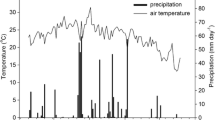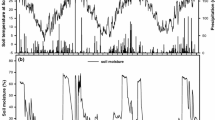Summary
The CH4 emission rates from Chinese rice fields have been measured in five typical areas representing all of the five major rice culture regions in People's Republic of China (P.R. China). Four types of diurnal variations (afternoon peak, night peak, afternoon-night double peaks and random pattern) of CH4 emission rates have been found. The first pattern was normally found in clear weather, the second and the third types were only found occasionally in particular place, while the fourth were found in cloudy or rainy weather. Due to the irregular pattern of the methane production observed in the morning-afternoon comparison experiment, the transport pathway influenced by certain factors, may be the major factor governing the diurnal variation of CH4 emission. Seasonal variation patterns of CH4 emission differ slightly with different field locations, where climate system, crop** system and other factors are different. Two and three emission peaks were generally found during single and early rice vegetation periods, with the peak magnitude and time of appearance differing to small degree in individual sites. A decreasing trend of seasonal variation was always observed in late rice season. A combination of seasonal change of transport efficiency and that of CH4 production rate in the paddy soil explains well the CH4 emission. The role of rice plant in transporting CH4 varied over a large range in different rice growing stages. The reasons for internnual changes of CH4 flux are not yet clear.
Great spatial variation of the CH4 emission has been found, which can be attributed to the differences in soil type and soil properties, local climate condition, rice species, fertilizer and water treatment. Experiments showed that while the application of some mineral fertilizers will reduce the CH4 emission and CH4 production in the soil, the application of organic manure will enhance CH4 emission and CH4 production in the soil. Any measures which can get off easily decomposed carbon from organic manure may reduce C supply for CH4 production, and hence reduce CH4 emission. Fermented sludges from biogas generators and farmyard-stored manure seem to be promising. In some parts of China, separate application of the organic and mineral manure instead of mixed application could be another option. Frequent Scientific drainage and ridge cultivation, which are often used water management techniques in Chinese rice agriculture, have been proved in the experiments to be a very efficient mitigation measures to reduce CH4 emission from rice fields.
By summarizing the present available data, China's rice fields contribute about 13.3 Tg yr−1 (11.4–15.2) CH4 to the atmosphere. The total methane emission from global rice fields can be estimated 33–60 Tg yr−1, much less than the estimates made before.
If we extrapolate the measured data in China with a consideration of measured data in other Asian country, the total global emission of CH4 from rice fields are estimated to be about 35–60 Tg yr−1
Similar content being viewed by others
References
Bachelet, D., Neue, H. U., 1993: Methane emission from wetland rice areas of Asia.Chemosphere (in press).
Butterbach-Bahl, K., 1993: Mechanisms of methane production and emission in rice fields. PH.D. Thesis, Fraunhofer Institute for Atmospheric Environmental Research, 82467 Garmisch-Partenkirchen, F.R. Germany.
Chen, D. Z., Wang, M. X., Shangguan, X. J., Huang, J., Rasmussen, R. A. Khalil, M. K. A., 1993: Methane emission from southwest China.Advances of Earth Sciences (in press).
Chen, D. Z., Wang, M. X., Shangguan, X. J., Shangguan, X. J., Toelg, M., Wassmann, R., **e, X. L., Wang, W. D., Shen, R. X., Wang, Y. S., Papen, H., Rennenberg, H., Seiler, W., 1994: Methane emission from rice fields in Hunan (PR China) III: influence of water management.Biogeochemistry (in prep.)
Chen, Z. L., Li D. B., Shao, K. S., Wang, B. J., 1993: Features of CH4 emission fron rice fields in Bei**g and Nan**g.Chemosphere 26, 239–245.
Chen, Z. L., Shao, K. S., Li, D. B., Wang, B. J., 1993: CH4 emission from rice fields and its relation to agriculture management. Personal communication (in Chinese).
Cicerone, R. J., Shetter, I. D., 1981: Sources of atmospheric methane: measurements in rice paddies and a discussion.J. Geophys. Res. 86, 7203–7209.
Cicerone, R. J., Oremland, R. S., 1988: Biogeochemical aspects on atmospheric methane.Global Biogeochemical Cycles 2, 299–327.
Climate Change, 1994: Radiative Forcing of Climate Change and an Evalution of the IPCC IS92 Emission Scenarious, Intergovernmental Panel on Climate Change, pp. 63–67.
Crutzen, P. J., 1991: Methane's sinks and sources.Nature 350, 380–381.
Dai, A. G., Wang, M. X., Shen, R. X., Schuetz, H., Rennenberg, H., Seiler, W., Wu, H. R., 1991: Methane emission from a rice paddy in Hangzhou of China during growing season of late rice.Scienta Atmospherica Sinica 37, 102–110 (in Chinese with English abstract).
Holzapfel-Pschorn, A., Seiler, W., 1986: Methane emission during a vegetation period from an Italian rice paddy.J. Geophys. Res. 91, 11803–11814.
Inubushi, K., Muramatsu, Y., Taja, D., Umebayashi, M., 1991: Practicability of reducing methane emission from paddy field. In: Aruga, Y. (ed.)Researches Related to the UNESCO's Man and the Biosphere Programme in Japan 1990–1991. pp. 47–50.
Khalil, M. A. K., Rasmussen, R. A., Wang, M. X., Ren, L. X., 1991: Methane emission from rice fields in China.Environ. Sci. Technol. 25, 979–981.
Mitra, A. P., 1992: Greenhouse gas emission in India (1991 methane campaign), prepared under the Auspices of Counil of Scientific Industrial Research and Ministry of Environment Forests.
Neue, H. U., Becker-Heidmann, P., Scharpenseel, H. W., 1990: Organic matter dynamics, soil properties, and cultural practices in rice lands and their relationship to methane production. In: Bouwman, A. F. (ed.)Soils and the Greenhouse Effect. Chichester: Wiley, pp. 457–466.
Sass, R. L., Fischer, F. M., Harcombe, P. A., Turner, F. T., 1991: Methane production and emission in a Texas agriculture wetland.Global Biogeochemical Cycles 4, 47–68.
Sass, R. L., Fisher, F. M., Wang, Y. B., Turner, F. T., Jund, M. F., 1992: Methane emissions from rice fields: the effect of floodwater management.Global Biogeochemical Cycles 6(3), 249–262.
Schuetz, H., Seiler, W., Conrad, R., 1989a: Processes involved in formation and emission in rice paddies.Biogeochemistry 7, 33–53.
Schuetz, H., Holzapfel-Pschorn, A., Conrad, R., Rennenberg, H., Seiler, W., 1989b: A three year continuous record on the influence of daytime, season, and fertilizer treatment on methane emission rates from an Italian rice paddy field.J. Geophys. Res. 94, 16405–16416.
Schuetz, H., Seiler, W., Renneberg, H., 1990: Soil and land use related sources and sinks of methane (CH4) in the context of the global methane budget. In: Bouwman, A. F. (ed.)Soils and the Greenhouse Effect. Chichester: Wiley, pp. 268–285.
Seiler, W., Holzapfel-Pschorn, A., Conrad, R., Scharffe, D., 1984: Methane emission from rice paddies.J. Atmospheric Chemistry 1, 241–268.
Shangguan, X. I., 1993a: Processes of methane production and emission from Chinese rice fields. PH.D. Thesis, Institute of Atmospheric Physics, Academia Sinica, 100029 Bei**g, R.P. China.
Shangguan, X. J., Wang, M. X., Shen, R. X., Wassmann, R., Toelg, M., Papen, H., Rennenberg, H., 1993b: The influence of temperature on diurnal and seasonal variation of methane emission.The Journal of Graduate School, Academia Sinica. (in press).
Shangguan, X. J., Wassmann, R., Wang, M. X., **e, X. L., Toelg, M., Chen, D. Z., Wang, W. D., Shen, R. X., Wang, Y. S., Papen, H., Rennenberg, H., Seiler, W., 1993c: Methane emission from rice fields in Hunan Province (PR China) I: Influence of mineral vs. organic fertilizers. Biogeochemistry (to be submitted).
Toelg, M., Shangguan, X. J., Chen, D. Z., Wang, M. X., Wassmann, R., **e, X. L., Wang, W. D., Shen, R. X., Wang, Y. S., Papen, H., Rennenberg, H., Seiler, W., 1994: Methane emission from rice fields in Hunan Province (PR China) II: Temporal variation of methane emission.Biogeochemistry, (in prep.)
Wang, M. X., Khalil, M. A. K., Rasmussen, R. A., 1987: Flux measurement of CH4 emission from rice fields and biogas generator leakages.Chinese Science Bullet 21, 1646–1649.
Wang, M. X., Dai, A. G., Shen, R. X., Schuetz, H., Renennberg, H., Seiler, W., Wu, H. B., 1990: CH4 emission from a Chinese rice paddy field.Acta Meteorological Sinica 4, 265–275.
Wang, M. X., Dai, A. G., Huang, J., Ren, L. X., Shen, R. X., Schuetz, H., Seiler, W., Rasmussen, R. A., Khalil, M. A. K., 1993a: Methane source from China.Scientia Atmospherica Sinica 17(2), 52–64.
Wang, M. X., Shangguan, X. J., Shen, R. X., Wassmann, R., Seiler, W., 1993b: Methane production, emission and possible control measures in the rice agriculture.Adv. Atmos. Sci. 10(3), 307–314.
Wassmann, R., Schuetz, H., Papen, H., Rennenberg, H., Seiler, W., Dai, A. G., Shen, R. X., Shangguan, X. I., Wang, M. X., 1993a: Quantification of methane emissions from Chinese rice fields (Zhejiang Province) as influenced by fertilizer treatment.Biogeochemistry 20, 83–101.
Wassmann, R., Papen, H., Rennenberg, H., Seiler, W., Wang, M. X., Shangguan, X. J., 1993b: Adequate fertilizer application as an essential element in intercomparative studies on methane emission from rice fields. Paper for ECE/PRC Workshop on Contribution to Global Change, October 1992, Bei**g.
Wassmann, R., Wang, M. X., Shangguan, X. J., **e, X. L., Shen, R. X., Wang, Y. S., Papen, H., Rennenberg, H., Seiler, W., 1993c: First records of a field experiment on fertilizer effects on methane emission from rice fields in Hunan Province (PR China).Geophys. Res. Lett. 20, 2071–2074.
Wassmann, R., Shangguan, X. J., Toelg, M., Chen, D. Z., Wang, M. X., Papen, H., Rennenberg, H., Seiler, W., 1994: Evidence of a potential reduction of methane emission from rice fields by a separate application of mineral and organic fertilizers. Biogeochemistry (in prep.)
Xu, Q., 1981: Crop** system in relation to fertility of paddy soils in China. In: Institute of Soil Science, Chinese Academy of Sciences (ed.)Proceedings of Symposium on Paddy Soil. Science Press, Bei**g-Springer, Berlin, pp. 92–100.
Yagi, K., Minami, K., Ogawa, Y., 1990: Effects of water percolation on methane emission from paddy fields.Res. Rep. Div. Environ. Planning 6, 105–112.
Author information
Authors and Affiliations
Additional information
With 2 Figures
Rights and permissions
About this article
Cite this article
Wang, M.X., Shangguan, X.J. CH4 emission from various rice fields in P.R. China. Theor Appl Climatol 55, 129–138 (1996). https://doi.org/10.1007/BF00864708
Received:
Revised:
Issue Date:
DOI: https://doi.org/10.1007/BF00864708




